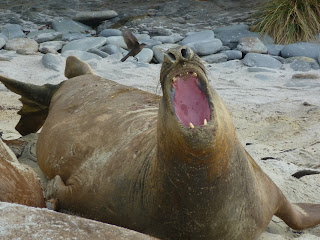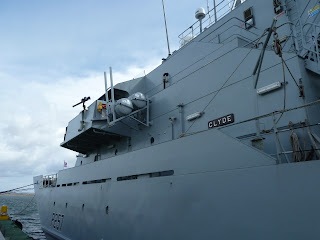[An occasional insight into life in the Falklands for some expats from the suburbs of London. This week, we do our tourist bit, while showing a visiting friend around.]
After months of waiting, our friend (let's call her "Bx") was finally arriving at Mount Pleasant Airport, 35 miles down a very bumpy road from Stanley, the main town. Despite the lack of traffic on the roads, we contrived to arrive after the weekly LAN flight from Chile had touched down. But, luckily, the formalities at the small airport delayed Bx about an hour, so we managed to be there when she emerged from Customs and Immigration.
(Usually the flight is virtually empty, but there was a major conference in Stanley last week, and delegates were arriving 'en masse'.)
 |
| Bull Sea Lion heading for Tussac grass |
Bx was only in the Falklands for a week, so we planned to tour East Falklands and visit an island that was good for wildlife. She also had a strong interest in the 1982 War, so we hoped to see some people and sights associated with that. However, we had underestimated how helpful Falklanders can be.
 |
| 55 stones, 770lbs., 350kg of rippling muscles. 3 times the size of the female. |
Our first stop was a Farmhouse self-catering cottage near the San Carlos landing beaches, where British troops came ashore in 1982. Although self-catering, we enjoyed a delicious dinner and breakfast, due to the owners taking pity on me forgetting to bring food! Over breakfast, we chatted with the owners who were interested to know if Bx knew anyone in the Falklands. She admitted that she'd exchanged Christmas cards 30 years earlier with a couple who ran a farm, but assumed they had passed away, as they had been elderly then, and contact had been lost. However, our hosts reassured her that the couple were in their 90s, and living in Stanley!
 |
| Very few rockhoppers still around. |
A few days later, we bumped into someone else who knew the farming couple, and assured us that Bx would be made welcome to say "Hello!". So, we popped round to the sheltered accommodation and introduced ourselves. The ex-farmer was happy to chat about his time on the farm: "100,000 acres - took a while to get around on a horse!", but just meeting him had been rewarding and totally unexpected. It was typical of how Falklanders try to make a visit special. (By the way, 100,000 acres is slightly bigger than the Isle of Wight!).
 |
| Striated caracara. Very rare. |
Thereafter, the week ran more to plan: seeing penguins at Gypsy Cove; enjoying some excellent meals in Stanley; visiting outlying communities like Goose Green and Darwin.
And to make sure Bx saw as much Falklands wildlife in a short space of time, we also had a flying visit to the Nature Reserve that is Sealion Island.
http://www.sealionisland.com/
 |
| Gentoo penguins |
After a 40-minute flight in an 8-seater plane, with Bx sitting beside the pilot, we arrived in time to squeeze into a LandRover taking guests to the far end of the island, about 5 miles away. Pausing only to grab a packed lunch, we headed off on grass tracks to see the residents.
 |
| Caracara hoping, in vain, for some crumbs. |
Passing geese, skuas, shags, terns, and two old horses, we were dropped off near the memorial to the HMS Sheffield, which had been sunk by an Exocet missile near the island in the '82 war.
http://en.wikipedia.org/wiki/HMS_Sheffield_(D80)
 |
| Dreaming of squid..... |
We knew from a previous visit, that this spot was where the Rockhopper penguins bred, and there was clear evidence thousands had been there until recently. But, sadly for us, all but six had now left the island and returned to the ocean for another year.
 |
| Is that a wink? |
Undeterred, we set off along the cliffs to explore the island. Near a sheltered bay, we encountered a huge bull Sea Lion, which I was quite glad not to have stumbled across in the tussac grass. He was definitely unhappy with our presence, so we backed off to find a quieter spot to have lunch.
 |
| Yaaaaaaaaaaawn! |
Further along the cliffs, we found a ledge which allowed us to look down on snoozing sea lions, without disturbing them. We were soon joined by a curious Caracara, a very rare bird, which is mainly found in the outlying Falkland Islands. Although it is obviously a raptor, its preferred method of attack is to run at prey and jump on it! A great strategy for taking ground-nesting birds, especially flightless ones, but not so useful when you meet cats for the first time. So, the Striated Caracara is restricted to islands where cats have not been introduced.
http://en.wikipedia.org/wiki/Caracara
 |
| "Oi, Big Boy! Over here!" |
After lunch, we strolled through the dunes and came across a monster of the deep - a male elephant seal. The males weigh up to 3 tonnes, mostly blubber and fur (which is why they were hunted, almost to extinction). They spend a few months of the year on remote beaches like those on Sea Lion Island to breed and renew their fur.
http://en.wikipedia.org/wiki/Elephant_seal
These behemoths can hold their breath for over an hour under water, but at this time of year, they are largely conserving energy, gently snoozing in groups tightly squashed together. When they were being killed for their (blubber) oil, men would sit on their backs for amusement, and ride the bucking bronco.
But we saw one seal with a bad gash on its back bucking and twisting in pain, as small birds pecked away at the cut. I didn't fancy getting too close....
 |
| Skuas defending their potential meal of a gull chick. |
Jenny, the excellent hostess at SeaLion Lodge, informed us that the breeding season for some animals seemed to be a few weeks advanced (hence the lack of Rockhopper penguins), and others, such as skuas, were delayed.
 |
| Gull mobbing Skuas. |
Normally, skuas will viciously attack anyone walking near their young, but we were amazed to be able to walk unscathed past fluffy chicks. However, the normal prey for skuas, penguin chicks, were now too large for the skuas to catch, so they were experimenting with other prey.
 |
| Gentoo chick on nest, showing its toilet trajectory. |
We witnessed a prolonged battle over a gull chick, which was grabbed by a pair of skuas when it wandered too far from the rest of the flock. However, the adult gulls produced a sustained mobbing of the skuas, which eventually led to the chick escaping to the bosom of its family.
 |
| Furry Skua, and penguin, chicks. |
All in all, it was a amazing insight into the natural world. How male mammals are very aggressive in defending their territory; how predators need to kill to feed their chicks; and how safety in numbers is often the only strategy for young birds to survive to adulthood.
And all this without seeing any orcas. These efficient hunters had apparently been frequent visitors earlier in the season when the elephant seal pups made their first forays into the sea. Dozens had been killed, and several camera crews had visited to capture the dramatic scenes. Expect another BBC Wildlife programme to be released soon!
 |
Gentoo penguins auditioning for "The Sound of Music"!
(Thanks, Bx!) |
Meanwhile, back in Stanley, we said sad farewells to Bx, whom we hoped had had her curiosity about the Falklands satisfied. Normal activities resumed. Some cruise ships appeared on the horizon and one or two actually managed to land passengers, despite the wind. I was a busy Penguin Warden again, answering questions like - Why aren't these penguins as big as the ones on TV? What do you feed them? When do they dance...? Sometimes the weather was unfriendly, but on one morning I saw dolphins 3 times, which makes up for the hail and horizontal rain.
 |
| Star Princess about to disgorge 2,500 passengers. About the same number as live in the Falklands. |
~~~~~~~~~~~~~~~~~~~~~~~~~~~~~~~~~~~~~~~~~~~~~~~~~
My wife works in the tax industry and a few of her ex-colleagues in the UK have complained that I never mention tax on here........
Just to say we bumped into a couple from the Isle of Man on SeaLion Island, and at one point it seemed no-one cared about penguins or seals, as the conversation at the bar revolved around the riveting topic of the tax regimes of the Falklands, the Isle of Man and the UK. Still, it helped me catch up on my sleep!
And then, in Stanley, we were explaining to a friendly local who was having slight difficulty in hearing the conversation in a busy pub, that both my wife and Bx worked in Tax. Noticing that he hadn't quite heard, I said loudly that they both liked "TAX". Frowning, he replied, "Tacks? Oh, we had a shipwreck about 30 years ago, and all that could be salvaged was the cargo of tacks. We had enough tacks to last us years! Would you like some?"....
 |
| Magellanic penguin chick |
So, no more tax references here! Soon, the media representatives will be descending upon us, as the Referendum (on whether Falklanders wish to remain an UK Overseas Territory) looms. More on that later.
Peter





















































